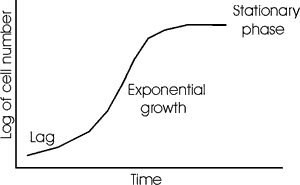
Exponential growth
Say we start with one cell, put it in minimal medium, where it and its daughter cells will grow and divide once every hour:

In minimal medium , E. coli divides typically in 60 min., or 1 generation= 60 min.
We can calculate how long it will take to get a billion cells from just one:
Let g = number of generations. 2 gens. --> 4 cells, 3 gens. --> 8 cells, or
N (no. of cells) =1 x 2g (starting with one cell).
If we started with 100 cells, after 1 gen. we would have 200 and after 2 gens. 400,
3 gens., 800 etc.
More generally, starting with No cells: N = No x 2g
Since we want to know how much time it will take: express generations in terms
of time.
If we let tD = the generation time, or doubling time, then the number
of generations that have passed during the time interval t is just t/tD: So g =
t/tD.
So now N = No x 2t/tD. One can thus see that growth is
exponential with respect to time.
Now we could solve this equation for t, since we know we want N to be 1 billion, No is 1, and tD is 1 hr. Taking the logarithm base 2 of both sides:
log2 (N/No) = t/tD, or t = tDlog2(N/No) = 1 X log2 (1,000,000,000/1) = log2(109)
But suppose your calculator doesn't do log base 2. No problem, convert to log base 10 ("log") or natural log base e ("ln").
log2X = logX/log2 = logX/0.3 and log2X = lneX/lne2 = lnX/0.69 (Also: 2x = 10xlog2 and 2x = exln2)
So log2(N/No) = log(N/No)/log2 = t/tD or log(N/No) = (log2/tD)t = Kt, where K=log2/tD or K=0.3/tD.
Or back to the exponential form: N/No =10Kt or: N =No10Kt
Or, since most scientific calculators have natural log functions:
N = NoeKt, where K = ln2/tD = 0.69/tD, another common form of the exponential growth equation.
We could also have approached this question of rates of change of N with time more naturally using calculus (Note: familiarity with calculus is not necessary for this course.) If you have a million cells, then after one generation time you’ll have gained 1 million. If you had 100, you would’ve gained 100. In general, the rate of increase of N with time is just proportional to the number of cells you have at any moment in time, or: dN/dt = KN
Separating variables: dN/N = Kdt.
Integrating between time zero when N = No and time t, when N = N:
lnN - ln No = Kt - 0, or ln(N/No) = Kt, or N = NoeKt
We can calculate the constant K by considering the time interval over which No
has doubled. This time is the doubling time, tD. For that condition:
N/No = 2 = eKtD. Taking the natural logarithm of both sides:
ln2=KtD, or K=ln2/tD, exactly as above.
In summary:
|
Base 2 | Base 10 | Base e |
| Exponential form | N = No2K2t | N = No10K10t | N = NoeKet |
Logarithmic form |
log2(N/No) = K2t |
log(N/No) = K10t | ln(N/No) = Ket |
Definition of constant |
K2 = 1/tD |
K10 = log102/tD = 0.3/tD |
Ke = ln2/tD = 0.69/tD |
All this looks worse than it is. Exponential growth using a base of 2 is intuitively obvious. And once you see the derivation, the exponential growth equation using log or ln can be simply applied to problems using a calculator. You just have to keep track of what you know and what you are after.
| Graphically, the depiction of exponential growth looks like this: |
Or, with the ordinate (Y-axis) plotted on a logarithmic scale, a semi-log plot: |

|

|
In reality, there's a lag before cells get going, and there's a limit (thankfully) to cell density, as nutrients become exhausted and/or toxic excretions accumulate. The final plateau is called stationary phase:

© Copyright 2000 Lawrence Chasin and Deborah Mowshowitz Department of Biological Sciences Columbia University New York, NY